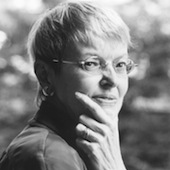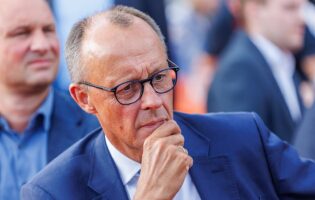Why Putin Fears Ukraine

Elizabeth Pond
Elizabeth Pond is a Berlin-based journalist and the author of Beyond the Wall and The Rebirth of Europe.
An eon ago, when the Berlin Wall fell and the Soviet Union imploded, the Kremlin still feared Germany. Its angst was anachronistic, but useful. Today President Vladimir Putin fears Ukraine. The angst is premature, and at this stage pernicious.
The contrast is instructive.
In his time, Russian President Mikhail Gorbachev still thought in terms of Lord Ismay’s adage that the transatlantic NATO alliance was intended “to keep the Russians out, the Americans in, and the Germans down.”
The Germans to be kept down were Hitler’s militaristic minions redux. Even though post-World-War-II Germans had effected one of the most dramatic transformations in history and turned themselves into self-effacing pacifists who atoned for Hitler’s aggression, the Russians still suspected that behind their mild exterior lurked atavistic warriors. It took President George H. W. Bush to trust the “citizens in uniform” of the new German army, override British and French forecasts of neo-Nazi recidivism, and endorse unification of West and East Germany.
In persuading Moscow not to veto unification the first Bush administration used the residual Russian fear of Germany to good advantage. State Department Counsellor Robert Zoellick presented Moscow with a list of advantages for Russia if it let the two Germanys merge peacefully and simply withdrew its 20-odd divisions from East Germany and Central Europe a thousand miles to the east. At the core of these advantages was the embedding of Bonn/Berlin in the transnational European Community and NATO, thus ensuring that Germany would not renationalize its foreign policy and become a loose cannon on the continent as its population grew overnight to become 25 percent larger than that of any other EC member.
In parallel, the government of German Chancellor Helmut Kohl greatly eased Moscow’s retreat from dominating Central Europe for two generations by identifying and removing a mundane barrier to Soviet military withdrawal – an acute lack of housing in the Soviet Union for returning troops. The Germans built extensive officers’ housing in the Soviet Union – and turned a blind eye to any corruption in the distribution of the new apartments. By 1994 the last Soviet enforcer troops left Central Europe, and the Germans assured them a dignified farewell that barred any eruption of triumphalism or bitterness by East Germans over the 44 years of Soviet hegemony. In an astounding end of empire, no blood was shed.
What happened next repeated the miraculous healing of the century-old French and German enmity that between 1945 and the fall of the Berlin Wall in 1989 gave heartland Europe its longest peace in history. The equally old enmity between Germans and Poles gave way to a growing democratic friendship that was interrupted only by the interregnum in Warsaw of the nationalist populist Kaczynski twins from 2005 to 2007. Equally important, the even older enemies of Poles and Ukrainians became reconciled as both struggled to lift their living standards above the meager Communist levels they inherited.
In the two decades since the break-up of the Soviet Union, Poland and Ukraine diverged sharply in their evolution, although they started from the same low standard of living. Economically, Poland enacted market reforms fast, fully joined the entrepreneurial West, curbed corruption, qualified for European Union membership, and tripled its per capita GDP to surpass Russia a decade ago. Ukraine, by contrast, followed the Russian development of a “Wild East”-form of capitalism of hugely rich, rent-seeking oligarchs and stagnated. Politically, Poland introduced real rule of law and protection of human rights, built strong judicial and parliamentary institutions, and embraced a culture of pluralism. By contrast, successive Ukrainian kleptocracies tortured and murdered human-rights activists, filled parliament with businessmen eager to gain MPs’ immunity from legal accountability – and under Viktor Yanukovych, the president who fled the country last February after his security forces shot more than 70 peaceful demonstrators on Kiev’s central square, let Russian advisers run the security organs.
Ordinary West Ukrainian villagers who traveled to Poland as traders over the past two decades saw the economic boom there and asked why Ukrainians remained so poor and had to pay so many bribes to survive. Many students, who took their countries’ 23 years as an independent state for granted and had no memory of life in the Soviet days, went to Poland to study. They came back asking why Ukraine couldn’t duplicate the tumultuous Polish intellectual buzz. And western Ukrainians as a whole concluded that their path to comfort and free lifestyles lay in emulating the Poles by getting in line for eventual EU membership.
When Yanukovych flirted for two years with the idea of signing an association agreement with the European Union but then abruptly dropped the idea last November under Russian pressure, West Ukrainians saw their future collapsing and rebelled. Led first by an Afghan Muslim who is a Ukrainian citizen and a leading investigative reporter, they began protesting in Independence Square, the Maidan – for Europe and democracy and against police repression and government corruption. They were soon joined by other dissatisfied citizens from central and even Russophone eastern Ukraine, and “Euromaidan” quickly became a permanent tent city of demonstrators, who organized themselves to provide food, latrines, clinics, seminars, security, and entertainment for their community. By December and January their numbers swelled to reach a cumulative one million.
By 2014 the Russians no longer feared the Germans. Had Putin still worried about German legions marching east, he would have been far more cautious about inciting Yanukovych to crack down on demonstrators as he himself had done in 2011-12 in routing the far smaller number of pro-democracy and anti-corruption protesters in Moscow. Nor would Putin have continued talking with Chancellor Angela Merkel as his one conduit to the West after his communications with the United States essentially broke down in May.
What Putin does fear, however, is the threat of a new “color revolution” in Ukraine that he maintains – and may actually believe – is instigated by the West. Back in the early 1990s various Russians accused Poles of having betrayed them in choosing a European over a Slav identity. But at least the Poles were western Slavs. The Ukrainians are eastern Slavs, the younger brothers (and centuries-long subordinates) of the Russians. For them to make the same choice is a betrayal that cuts to the bone of the Russians’ own self-identity. Moreover, this Ukrainian choice, if Kiev manages to replicate the Polish experience, could erode the East Slavic mystique that Putin now claims as the justification for his hard-line foreign and domestic policy.
The depth of Putin’s rage over traitorous Ukrainians was shown by the Russian president’s badgering of Yanukovych to resort to violence to drive out the Euromaidan protesters. Yanukovych finally did so this year, most lethally in late February. Yet the violence backfired. Instead of scaring off the pro-European and anti-corruption crowds, each new round of murders of unarmed demonstrators by sharpshooters only drew more supporters to Euromaidan. Yanukovych’s own party abandoned him, the president fled to Russia, and parliament appointed an interim government.
After seizing the Crimean peninsula from Ukraine in March with no Ukrainian military resistance, Putin attempted to destabilize the caretaker government in Kiev. Besides accusing it of being fascist in a barrage of propaganda, he massed heavily armed Russian infantry and air units on Ukrainian borders on three sides and feinted attacks for more than a month while a Russian colonel led a stealth war by local separatists to capture civic buildings in scattered towns in Ukraine’s two easternmost provinces. The latter action sparked no general revolt even by the Russian-speaking population, however, as Putin had apparently expected. On the contrary, opinion polls continued to show that a majority even of easterners preferred to stay in Ukraine rather than join Russia as the self-proclaimed Donetsk and Luhansk People’s Republics want to do.
And on May 25 a large majority of Ukrainians (minus the ballots of those who were prevented by gunmen from voting in the east) ended the interim gray zone. They elected as president billionaire Petro Poroshenko, who supported the Euromaidan movement from the beginning and has pledged to sign that association agreement with the EU and proceed fast with the economic and political reforms that the EU requires.
This is the threat that Putin fears the most: that Ukraine will now abandon its longstanding East Slavic habits and top-down clientelist governance altogether, implement bottom-up politics, become as rich and as democratic as the Poles and the northern Europeans – and an attractive model for a growing number of Russians who want to reform Putin’s own control system in Mother Russia.
The threat would seem far-fetched, given the Russian president’s 80-percent-plus popularity ratings after he annexed Crimea. But maybe Vladimir Putin knows something about his society that we do not.
This article appeared originally in the IP Journal, which is published by the German Council on Foreign Relations (DGAP).









